The reincarnation of the B6000C bread machine
Those of you who are, with me, fans of the Black & Decker B6000C bread machine should take a look at the West Bend model 47413 on sale at QVC right now.
I received a Black & Decker B6000C All-in-One Automatic Bread Maker for Christmas in 2014. I immediately liked it a lot, but it was my first bread maker, so I had nothing to compare it to. I didn’t realize how special it was until I tried to replace it after semi-accidentally screwing it up (more later). The B6000C itself and its parts were discontinued and, unsurprisingly, expensive from third parties. But there didn’t seem to be anything to replace it with. Most other bread machines only have one paddle. They make vertical loaves of bread. They make tiny loaves of bread.
I continued to make do with a degraded bread machine for another year because there was no replacement.1 It still continued to make bread fine. But it finally died two weeks ago. This time around, when I did a search for a three-pound breadmaker, I found the West Bend 47413 on QVC.
The 47413 is for almost all practical purposes the same machine. In fact, it’s so similar I suspect that they literally are the same machine, with minor changes to either improve it or to keep them from using interchangeable parts.
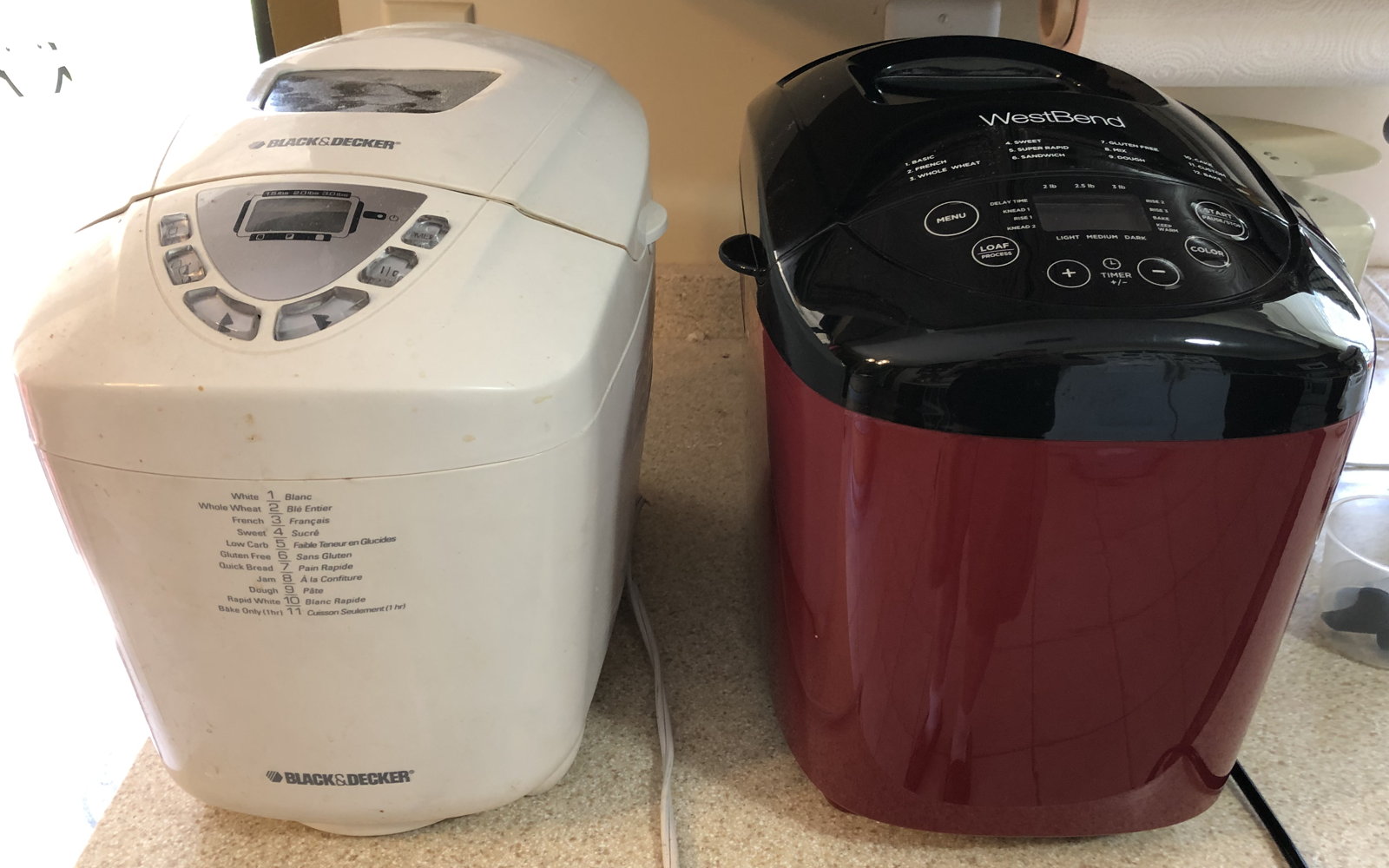
The old Black & Decker B6000C and the new West Bend 47413 Hi-Rise side-by-side. They are clearly very similar bread machines. A closer look, and they’re very likely the same bread machines, with some improvements in the West Bend.
The West Bend has changed a few settings.
- There is no longer a jam setting; I never used this, so it isn’t a problem for me. It’s possible you could make a jam setting out of the new “custom” setting.
- The low carb and gluten-free settings have been combined into one setting. I never used either, so for me this is not a loss. The West Bend’s gluten-free total time is a bit less than the Black & Decker’s. According to the Black & Decker manual, the low-carb setting took a whopping 4 hours and 30 minutes to complete. I suspect a typo. But if that’s real, the new Gluten/Low Carb setting is no replacement for the old Low Carb setting.
- The quick bread setting has been separated into two settings: one for mixing the quick bread without baking, and one for mixing and baking. Neither of these changes matter to me, as I never used the Black & Decker to make quick breads. Quick breads are easy enough that I don’t see the point of making them in the machine and having to deal with the paddles.
- The West Bend has a custom setting, which I suspect I’ll find a use for now that it exists. You can use it, as the name implies, to set custom times for the knead periods, the rise periods, and the bake period.
- The “Bake” setting’s baking time can be adjusted in ten minute intervals up to an hour, instead of always being an hour.
- There are twelve settings on the West Bend instead of the eleven on the Black & Decker. If you’ve been counting the changes, you’ll recognize that one’s still missing. That’s “Sandwich” bread, bread that is “lightly textured” with a “thinner crust”.
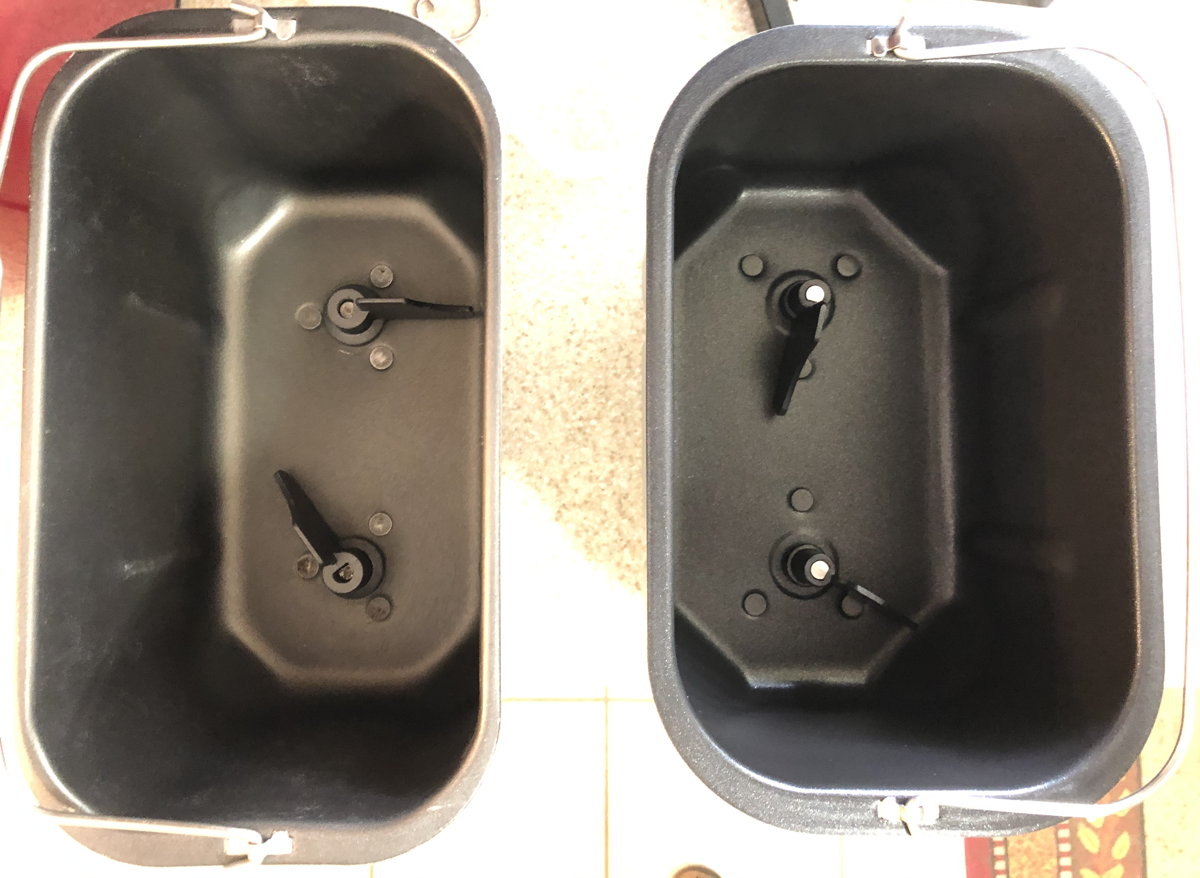
Looking at the bread pans from the top (Black & Decker on the left, West Bend Hi-Rise on the right) shows how similar they are. They’re nearly the same size, with the same design down to the beveling on the four corners. The West End is slightly wider.
The total baking times are a bit lower (and sometimes a lot lower) in the West Bend. The normal bread total time is three hours instead of three hours and eighteen minutes in the Black & Decker. I suspect this is going to be fine, because at least for me I almost always used the “light” setting. The medium setting was too dark for me. Now I expect to use the medium more often.
Instead of beeping for additional ingredients such as nuts and fruit after the first kneading, it beeps “during the second kneading”. This means waiting longer to put these ingredients in and go on with other work (about forty minutes instead of twenty-five minutes on the basic setting). Presumably this is an improvement: it means that more kneading is done before these ingredients potentially interfere with the kneading.
That said, I never had any problems with adding ingredients after the first kneading other than sometimes missing the beep, which is likely to happen more often now that the beep occurs later on—although the ten beeps signaling the time to mix things in is hard to miss. The new stage indicator arrow will also help.
The basic recipes in the manual are mostly different recipes, so non-comparable; the basic white bread, however, is nearly exactly the same as in the Black & Decker manual. I can’t say anything further about the recipes, as I only used the manual’s recipes to compare with recipes from Donna Rathmell German’s bread machine series to determine whether I should use the small, medium, or large setting.
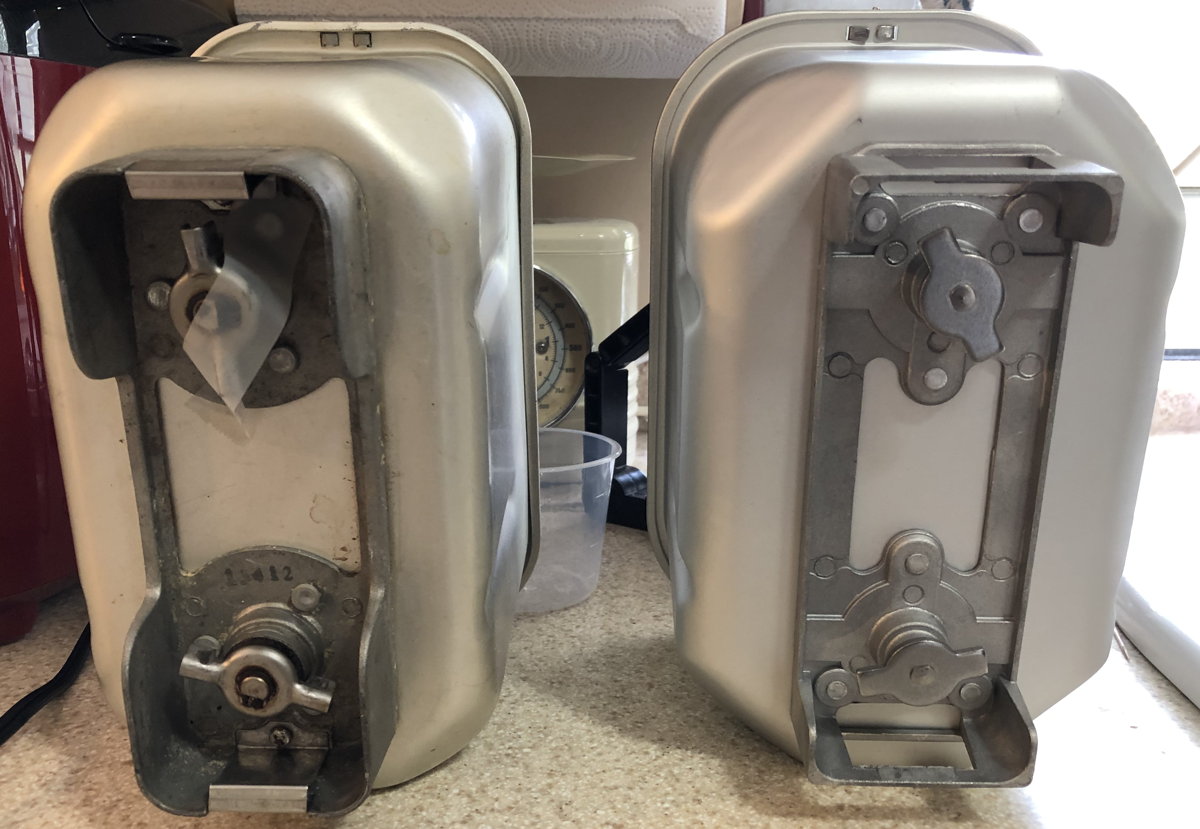
The underside of the bread pans (West Bend Hi-Rise on the right) again shows the similarities—and the difference in how they attach to the bread machine. (The tape on the Black & Decker was to hold the crossbar in place while I took the photo.)
And on the topic of size, one potentially important difference is that where the Black & Decker had default settings for 1-½ pound, 2 pound, and 3 pound loaves, the West Bend has default settings for 2 pound, 2-½ pound, and 3 pound loaves. This counts as an improvement to me. I never used the Black & Decker’s 1-½ pound setting but might end up using the West Bend’s 2-½ pound setting.
Presumably you could create a 1-½ pound setting using the customization feature, since the bread pan and paddles are nearly identical.
Power failure backup is listed as ten minutes instead of the Black & Decker’s seven minutes.2
The LCD screen is a lot easier to read. The numbers are darker on the LCD and the labels are clearer around it. And there’s an indicator to tell which phase the bread is in, whether it’s the first or second knead or the first, second, or final rise. This will tell you if it’s getting close to time to add extra ingredients, if you’re worried you missed the ten beeps.
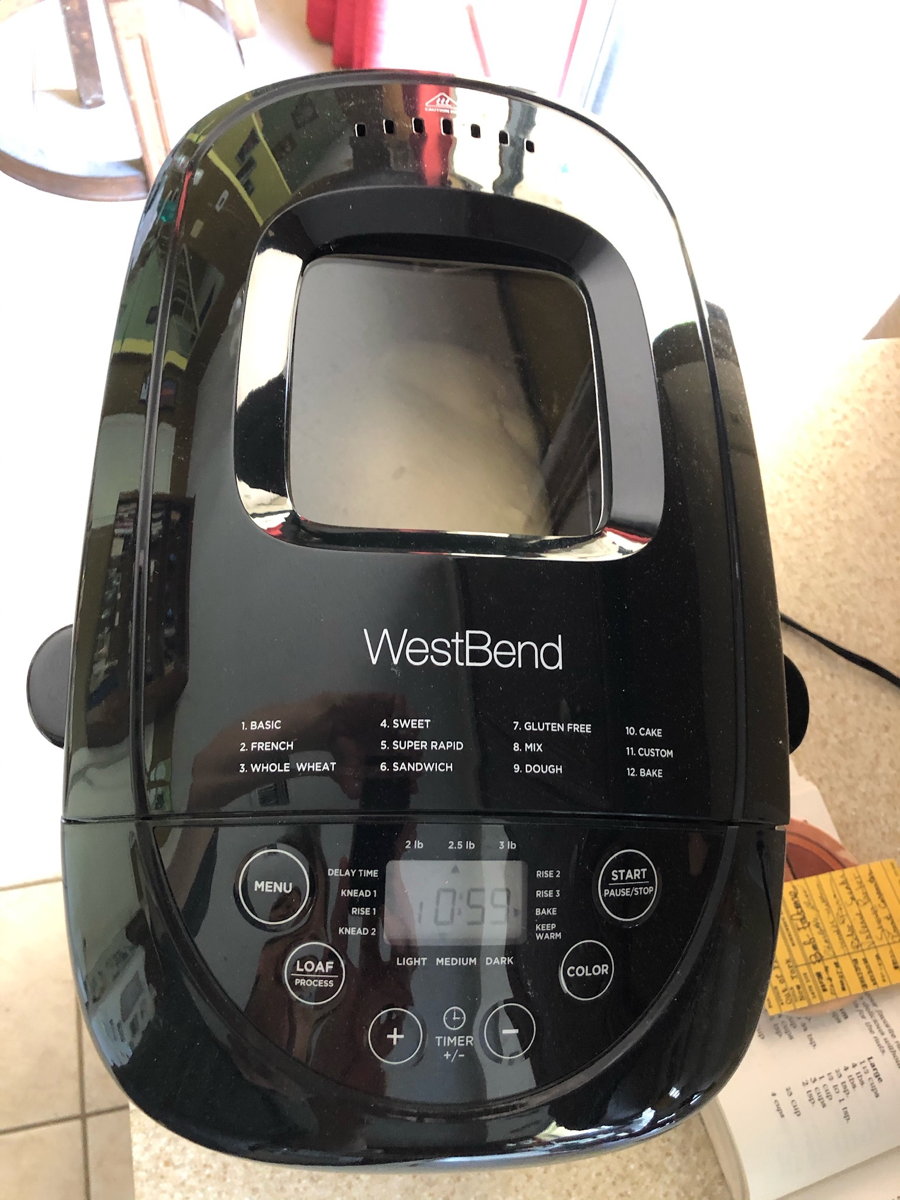
At this point, the bread machine has just entered the “bake” stage—you can see the arrow in the lower right of the LCD.
It comes with a tool for removing the paddles from the bread for the “occasional” times when the paddle remains in. My experience with the B6000C is that this “occasion” is almost all the time. The tool is a nice feature, as I always ended up using a detached beater from a hand mixer to wiggle the paddles out. That said, on my first loaf of bread the bread slid out nicely leaving the paddles in the pan.
The only real downgrade from the Black & Decker is an extremely minor one. The cheap plastic measuring cup that comes with the West Bend only measures up to one cup, instead of the one and a half cup of the Black & Decker’s cheap plastic measuring cup. I actually do use the Black & Decker’s measuring cup regularly because it goes to 1-½. Even there, however, the West Bend’s measurements are (at least initially) easier to read.
The double-headed teaspoon/tablespoon is nearly the same.
Sadly, when I say that they are the same for almost all practical purposes, the “almost” is because the parts are not interchangeable. The bread pans are nearly the same size with the same basic design. But where the Black & Decker has a catch on the bread pan and a space for the catch to snap in on the machine, the West Bend has a catch on the machine and a space for it to snap in on the pan. This means that you cannot use the bread pan for one in the other. The shape is slightly different; if you look closely at the photo, you can probably tell that the West Bend is slightly wider than the Black & Decker. This means I’ll need to build a new bread slice guide.
I had had hopes of keeping the B6000C and putting a new bread pan in it by ordering a second pan for the West Bend. The B6000C itself still works. The reason I was looking for a replacement is that I destroyed the bread pan by cleaning it in the dishwasher for the first year or so of use. When I noticed that this was degrading the seal that separates the inside from the outside of the bread pan, I stopped, but one of the seals finally broke completely a few weeks ago and the axle will no longer stay in the pan, nor keep liquids in the pan from running out into the heating area.
While replacement bread pans are technically available for the B6000C on the aftermarket, they run about $70. The West Bend is currently $90 on QVC, and if you’ve never ordered from them before, you can get a $10 first-time-shopper discount. That made it a no-brainer to just get the new unit.
But that leaking bread pan brings me to another improvement in the West Bend’s manual. Where the Black & Decker manual said specifically that the dishwasher was fine, the West Bend manual specifically tells you not to use it. So even though my hopes of running two bread machines at once have been dashed, I have decent hopes that this machine will last even longer than my B6000C did.
I’m still going to order an extra bread pan just in case, while they’re still available.
In retrospect, this was pretty stupid. The pan was clearly leaking small amounts of liquid into the heating area.
↑The manual is unclear on this. In the description of the feature on page 6, it says ten minutes. In the troubleshooting section on page 13, it implies five minutes.
↑
- 3 lb. Hi-Rise Bread Maker at West Bend® Kitchen Appliances
- “The Hi-Rise™ Bread model 41410 maker includes dual knead blades to provide thorough dough kneading for a lighter taste and higher rise! This bread maker can accommodate 3 different loaf sizes.”
- Bread Machine Maintenance at Bread Machine Digest
- “While you will not find this in your bread machine manual, it is a good idea to periodically oil your bread pans kneading shaft(s). This helps keep it moving freely, it helps kill any rust that may have formed and it will even help make the machine run quieter.”
- The Donna Rathmell German Bread Machine Cookbook collection
- Donna Rathmell German’s little cookbooks, from the Nitty Gritty collection, are a great companion to your bread machine and a great lesson in using bread machines to make bread.
- National Sandwich Day: Do-it-yourself bread slice guide
- If you have a table saw or chop saw, making a bread slice guide is a snap.
More bread
- Graham bread in the crockpot
- Grandma’s “Dark” Bread, from the original Crock•Pot manual, is a wonderful graham-flour bread and very easy to make in a coffee can in your slow cooker. It’s a great choice for National Sandwich Day this November 3.
- Eddie Doucette’s Potato Bread
- This is an amazing bread for breakfast or sandwiches, easily made in a bread machine. It’s a great choice for National Sandwich Day this Friday.
- Club recipe archive
- Every Sunday, the Padgett Sunday Supper Club features one special recipe. These are the recipes that have been featured on past Sundays.
- Padgett Sunday Supper Club
- Dedicated to the preservation of vintage recipes.
- The Donna Rathmell German Bread Machine Cookbook collection
- Donna Rathmell German’s little cookbooks, from the Nitty Gritty collection, are a great companion to your bread machine and a great lesson in using bread machines to make bread.
- Nine more pages with the topic bread, and other related pages
More bread machines
- The Donna Rathmell German Bread Machine Cookbook collection
- Donna Rathmell German’s little cookbooks, from the Nitty Gritty collection, are a great companion to your bread machine and a great lesson in using bread machines to make bread.
- National Sandwich Day: Whole Wheat Sesame Bread
- To be honest, I’m not sure the whole wheat bread from The Enchanted Broccoli Forest is even doable by hand. But I have managed to modify it so that it works very well in a bread machine.
- Bread machine ka’ick
- Varying a Syrian recipe from Helen Corey, this anise and mahleb-flavored bread is perhaps the best tomato sandwich bread I have ever tasted.

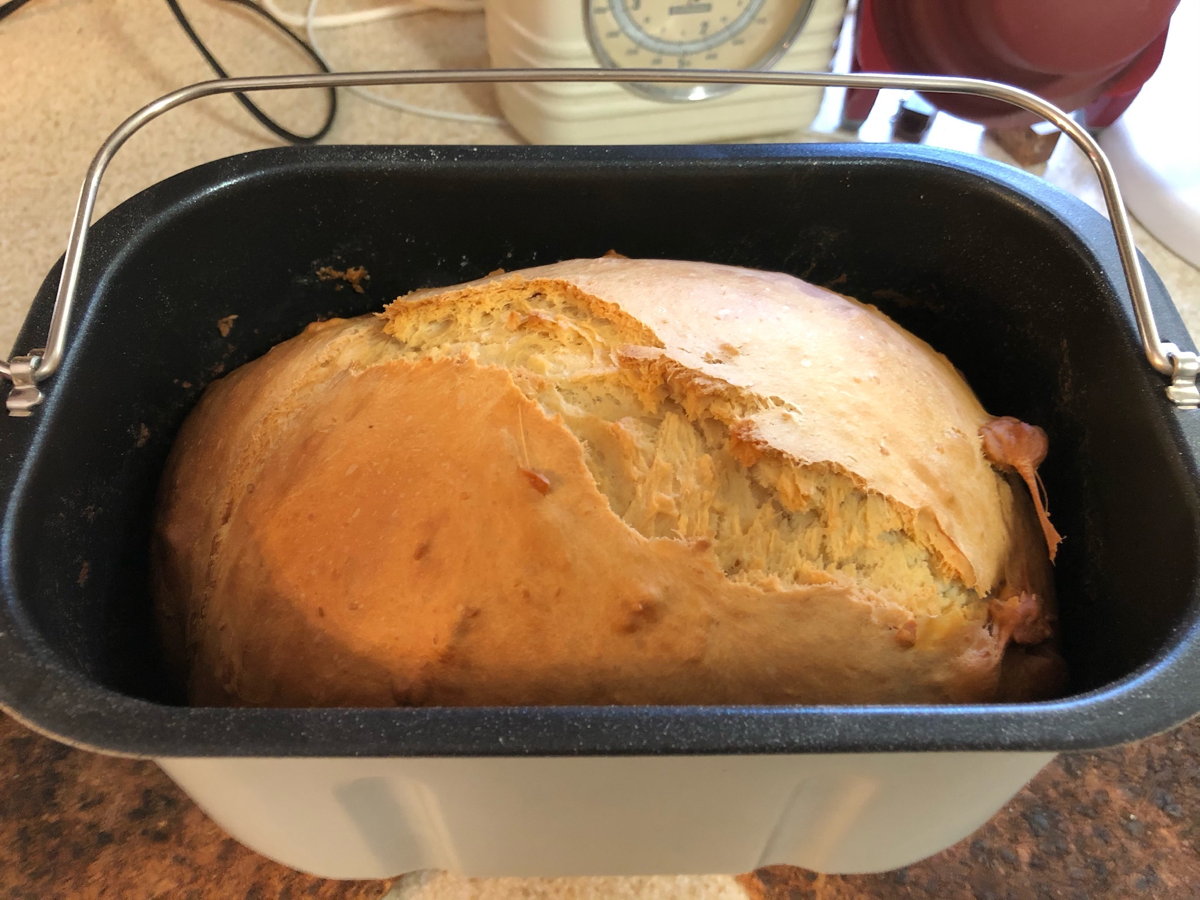
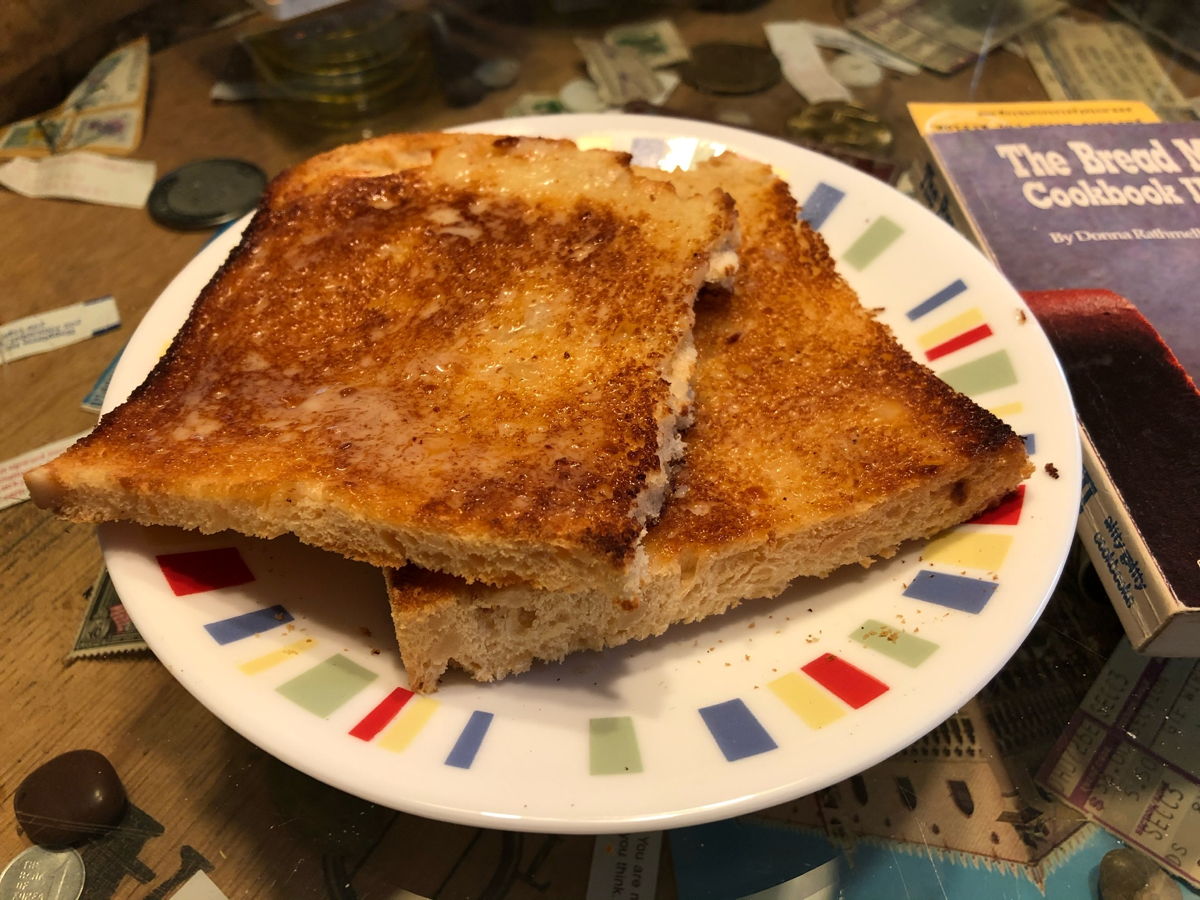
Good day,
My wife and I also own the Black & Decker bread maker mentioned here and we just love it. My Pan encountered damaged by getting dropped on the ground and being quite deformed. I have since bent it back but, it's still not quite right and I was also looking for a new bread pan online when I came across your article here. Nice little right up by the way very well detailed I greatly appreciate this.
I wanted to mention however I do believe you can easily replace the seals on your old black & Decker pan. You simply need to remove the snap ring on the bottom of the shaft that goes through the pan and engages the kneading paddles. It should be a simple o-ring or two that needs replacing inside the casting that retains the drive shafts for the kneading paddles. You should be able to bring in the old o-rings into your local automotive parts store outlet and they should be able to match them up with new o-rings for you.
If you would like more information I would be glad to help, I'm an old automotive mechanic by trade and would be happy to help you out with this fix over the phone. It is possible I could disassemble mine and match up the parts for you to order if required. I understand the importance of retaining quality equipment that no longer offers replacement parts I would like to see you having wonderful breads again out of your old Black & Decker.
I realize you posted this just over 3 years ago. Hopefully you've already found a fix for your old bread maker but if not hopefully it's not too late and you still have it.
Cheers,
James LaRouche
James LaRouche in Kamloops BC Canada at 5:08 p.m. May 23rd, 2024
ZQnW/
Thanks! I still have the old one stored away, I’ll have to take a closer look at it.
Jerry in Texas! at 2:27 a.m. June 3rd, 2024
XPwsk
Hello, I also have a Black & Decker B6000C bread maker with a leaking pan. I removed the snap ring on the bottom of the shaft and couldn't get the shaft to come out. I believe there may be another snap ring between the pan and the base that's riveted together. Any comments or help would be greatly appreciated.
Thanks for your time, Chris.
Chris in Belleville Ontario Canada at 8:21 p.m. June 8th, 2024
5rp5s
I Recently got a B6000C from my Grandmother and after 7 or 8 batches i noticed a puddle on the counter. However my Axle has no issues slipping in and out on the busted one, i relaized that there is a rubber O-Ring within the sealing mechanism that also doubles to hold the axle in place, its located about a 1/4 inch from the inside of the pan and once you remove the outer snap ring, a swift mallet blow to the underside pops it right out. That is all that keeps the liquid in the pan and luckily you dont have to get the actual Black and Decker part, just find an o-ring that fits snuggly and requires a good press to get the axle back in. Thats how i fixed my bread maker. A 15 cent o ring from home depot.
Hark Thrice at 9:58 p.m. June 30th, 2024
bB4Xz